Contrapuntal Allusions in Masses
The first comparisons of contrapuntal lines in Masses and chansons are intended to show how close the correspondences could be. They juxtapose chanson motives with Mass motives that are not taken from the chanson sung in the tenor. In the anonymous Missa in SPB80 (fols.
[8] Graeme Boone, "Dufay's Early Chansons: Chronology and Style in the Manuscript Oxford Bodleian Library, Canonici 231," 136.
EXAMPLE 57. Anonymous, Missa (SPB80, fols. 129v-43), Crucifixus at "Et resurrexit"

129v-43), three voices of the Et resurrexit (Ex. 57) may refer to a secular composition without a known text, the chanson by Constans in Tr90 just noted for its similarity to De plus en plus se renouvelle (Ex. 56b). The next of these preliminary comparisons involves an interior phrase. In the Kyrie I of Caron's Missa Accueilly m'a la belle the second phrase (mm. 4-8) makes its own citation of Binchois's De plus en plus (Exs. 58a and b). Caron here creates a double allusion, because the second phrase of his chanson Accueilly m'a la belle (Ex. 58c) is also plainly related. The reference in the Mass to Binchois becomes distinctive in the second half of the phrase, when Caron replaces the chanson with the same short cadential figure used by Binchois. Perhaps because Caron had no option in a Kyrie of relying on a secular text to draw attention to his melodic citation, the motivic resemblance to De plus en plus is stronger than in either of the chansons discussed above in Example 56. The same reason may apply to Example 59, where the chanson Pourtant se mon voloir s'est mis by Caron (or Busnois) is virtually quoted in the Benedictus of the Missa Pour l'amour (and less extensively at the Christe), attributed to Faugues.
Textual correspondences and contemporary rhetorical practices make it unlikely that all of these similarities are purely melodic coincidences. Of the possible quotations cited in earlier chapters, one presented in chapter 6 (Ex. 2i)—namely, Le Rouge's Se je fayz duel and the Qui sedes of Faugues's Missa La basse danse —has an affinity between the sacred and secular texts that was not discussed. The allusion at the injunction "You who sit at the right hand of the Father, hear our prayer" is to the lament of pain and suffering voiced in the chanson. To include an example from earlier in the century, the Cum Sancto of an independent Gloria setting by Du Fay in Tr92 quotes
EXAMPLE 58. Motivic comparison of (a) Binchois, De plus en plus , mm. 1-5; (b) Caron, Missa Accueilly , Kyrie I, mm. 4-8; and (c) Caron, Accueilly m'a la belle , mm. 8-12
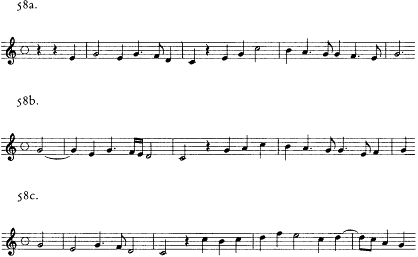
EXAMPLE 59. Motivic comparison of (a) Caron (or Busnois), Pourtant se mon voloir s'est mis , mm. 1-7; and (b) [Faugues], Missa Pour l'amour , Benedictus, mm. 1-8
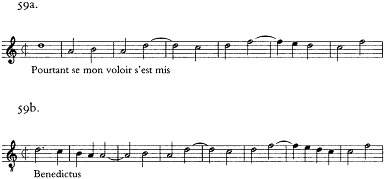
EXAMPLE 60. Motivic comparison of (a) Du Fay, Adieu, quitte le demeurant , mm. 1-3; and (b) Du Fay, Gloria (no. 28), at "Cum sancto"

from Du Fay's chanson Adieu, quitte le demeurant de ma vie (Ex. 60). The combined imagery of the chanson (leaving "the abode" of one's life) and the Mass ("with the Holy Spirit in the Glory of God the Father") suggests a vision of life after death, whether for Christ or a recently deceased acquaintance of Du Fay.[9]
Several motivic allusions with possible textual significance occur in the anonymous Missa in SPB80 on fols. 90v-98v. The Cure Sancto begins with the same motto as the Busnois setting of Regina coeli laetare (I) (Ex. 61a); then at the Credo text "Et ascendit" there is an extended similarity to the phrase "Me fait celle qui passe route" in the Hayne chanson De quatre nuyts (Ex. 61b); and the Benedictus also suggests Hayne (Ex. 61c). Both voices of this duet closely resemble the second half of Hayne's chanson Ce n'est pas jeu at the verse "Accompaigné de deuil."[10] In an allusion that recalls the prophecies Jesus made in the Sermon on the Mount, the composer therefore appears to suggest that
[9] This Gloria is in Guillaume Dufay, Guillelmi Dufay Opera Omnia , vol. 4, no. 28. Among quotations noted by others, there are those Besseler cited in his foreword to this volume of Mass fragments; and Charles Van den Borren suggested that Brumel based the "Et unam sanctam" in the Credo of his Missa De beata virgine on Compère's Nous sommes de l'ordre de Saint Babouin . The connection between an identification with a special Order and the belief in "one, holy, catholic, and apostolic church" is hard to miss; see Van den Borren, La musique en Belgique de moyen âge à nos jours , 80-81; and also Ludwig Finscher, Loyset Compare (c. 1450-1518) , 241-42.
[10] For an edition, see Marix, Les musiciens , no. 67.
EXAMPLE 61. Motivic comparison
EXAMPLE 61A . (i) Anonymous, Missa (SPB80, fols. 90v-98v), Cum sancto; and (ii) Busnois, Regina coeli laetare

EXAMPLE 61B . (i) Anonymous, Missa (SPB80, fols. 90v-98v), Et incarnatus at "et ascendit"; and (ii) Hayne, De quatre nuyts at "Me fait celle"

EXAMPLE 61C . (i) Anonymous, Missa (SPB80, fols. 90v-98v), Benedictus; and (ii) Hayne, Ce n'est pas jeu at "Accompaigné de deuil"
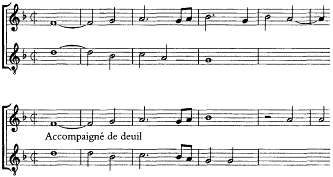
the "blessed who walk in the name of the Lord" are those "accompanied by sorrow."
Contrapuntal references to a chanson could operate on two textual levels: as a commentary on the Mass text but also as an amplification of whatever poetic "theme" existed in the cantus firmus.[11] When Caron alluded to Binchois's De plus en plus in his Missa Accueilly m'a la belle (Ex. 58), he did so because the messages of the two chansons supplement each other. While the spurned singer of Caron's text complains of his inability to see or meet with his lady, that in De plus en plus declares his great desire to hear news of his "sweet Lady" and vows that his will to see her is "more and more ... renewed."
Another instance of this sort of textual relationship is present in one of the anonymous Masses in SPB80. The first motive of the anonymous chanson D'un bon du cuer sans aultre amer appears in the middle of the Qui tollis of the Missa D'ung aultre amer (Exs. 62a and b) at "Qui tollis peccata mundi, suscipe deprecationem nostram" [You who take away the sins of the world, hear our prayer]. At the final phrase of the chanson, when the poem returns to the words "aultre amer," the opening motive comes back in imitation at the octave (Ex. 62c). This imitation seems to have inspired the more taxing imitation at the second below in the Qui tollis. If the pairing of the poet's request for his love "not to love another" seems frivolous to include at the Qui tollis, the justification for this particular reference may be based on a pairing of one chanson about "un aultre amer" with another.
It was also possible for a citation to reverse the direction of the allusion, that is, for a chanson to allude to a Mass setting. In his Missa Caput Ockeghem uses a motive at "Et resurrexit" that compares closely to three chanson beginnings. Two of the chansons may well have been written by the same anonymous composer (Barbingant?), Terriblement suis fortunée and Fortune, n'as-tu point pitié . Yet the chanson with the strongest rhythmic as well as motivic similarity is Compère's Le renvoy d'ung cueur esgaré .[12] The textual concordance of the Resurrection and
[11] I discuss this sort of connection between Du Fay's Missa Se la face ay pale and Puyllois's He nesse pas grant desplaysir in "The Counterpoint of Allusion," 243-44.
[12] This example is in Reynolds, "The Counterpoint of Allusion," 240-41. Compère's imitative chanson doubtless follows the two anonymous nonimitative ones and is therefore perhaps another instance of Compare beginning a chanson with a motive first used by Barbingant. Regarding Terriblement suis fortunée and Fortune, n'as-tu point pitié , see ibid., 229-31.
EXAMPLE 62. Comparison of motives and counterpoint of (a) Anonymous, D'un bon du cuer sans aultre amer , mm. 1-4; (b) Anonymous, Missa D'ung aultre amer , Qui tollis, mm. 22-28; and (c) Anonymous, D'un bon du cuer sans aultre amer , mm. 41-45
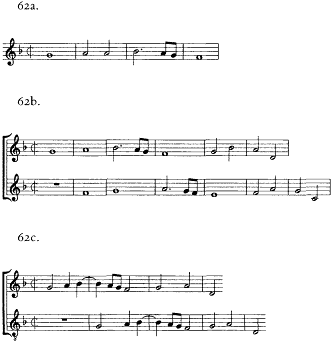
"the return of a heart misled" creates a convincing rhetorical image, regardless of which was composed first. To anyone who knew both the chanson and the Mass, the notes of one would call to mind those of the other. The debt of a secular work to sacred is particularly apt in this instance, since the superius of the chanson Terriblement suis fortunée quotes the chant melody Terribilis est locus iste .
In each of these examples, a chanson incipit appears to shape the melodic turn for a brief, textually related segment of a Mass by one
EXAMPLE 63. Motivic comparison of (a) Anonymous, Comme ung homme desconforté , mm. 1-9; (b) Busnois, Magnificat octavi toni , Et misericordia ejus, mm. 1-4; (c) Busnois, Magnificat sexti toni , Quia respexit humilitatem; (d) Lanoy, Missa , Agnus II, mm. 1-3; (e) Anonymous, Missa L'homme armé (Bol Q16), Agnus II, mm. 1-5; and (f) Martini, Missa Coda pavon , Patrem, at "Et homo factus est"
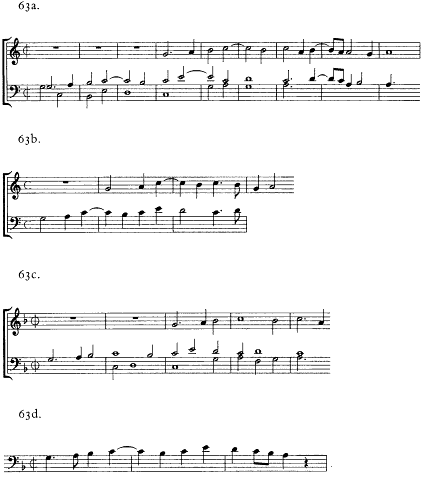
(continued )
EXAMPLE 63 (continued )
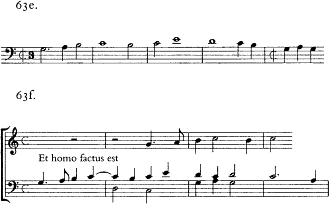
composer. However, there are clearer instances of allusive quotation in chansons that are cited in more than one work. Busnois, probable composer of the Magnificat Octavi toni (SPB80), quotes two voices of the anonymous Comme ung homme desconforté at the verse "Et misericordia" and three voices in his Magnificat Sexti toni at "Quia respexit humilitatem" (Ex. 63). Two Masses appear to cite the chanson tenor at the Agnus II, Lanoy's three-voice Missa (SPB80) and the anonymous Missa L'homme armé in BolQ16. And Martini has a more complete quotation in the Credo of his Missa Coda pavon at "et homo factus est." The image of someone "in great distress" suits equally well the plaintive tone of the Agnus Dei ("O Lamb of God have mercy") and the Magnificat verses "And His mercy is from generation to generation" and "Because he has regarded the lowliness of his handmaid." If this chanson casts a somber light on the Credo text "and He was made man," it should perhaps be related to fifteenth-century paintings of Madonna and child that portray Mary with an expression of grief, as if she knows from the outset the fate that awaits her child.
Multiple citations of a single chanson, or Masses that quote several phrases of a single chanson, offer a more secure means of identifying the presence of allusion or quotation than do single citations. Because Caron is the most active composer represented in SPB80 in this regard, and one particularly apt to quote from his own chansons, the following examples focus on his works.